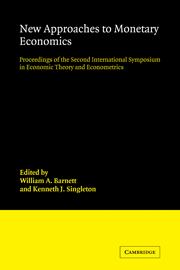 New Approaches to Monetary Economics
New Approaches to Monetary Economics Published online by Cambridge University Press: 04 August 2010
Arguments in favor of economic policy intervention are usually based on the existence of externalities. This mode of argument, long a tradition in microeconomics, is relatively new to macroeconomics. In the 1960s, for example, when Milton Friedman outlined in Capitalism and Freedom the pros and cons of government policy in many areas of economics, he centered his discussion around the existence of externalities in every area except macroeconomics.
Ever since the start of research on the microfoundations of macroeconomics in the early 1970s, many studies have attempted to correct this omission by casting proposals for macroeconomic policy in an externality framework. The vast majority of these studies has been concerned with externalities that relate to whether the natural or average rate of employment is inefficient. Few have been concerned with whether the observed fluctuations in employment around the natural rate are inefficient. In his 1972 book Inflation Policy and Unemployment Theory, Edmund Phelps summarized over a dozen externalities, all suggesting that the natural rate of employment is inefficient and higher than the optimum level of unemployment. Phelps mentioned externalities due to imperfect competition, information spillovers about conditions in the labor market from employed to unemployed workers, overpricing of labor due to lemon problems, failure to incorporate the value of self-respect from a good job, external effects of on-the-job training and experience, and income taxes that discriminate in favor of leisure.
To save this book to your Kindle, first ensure [email protected] is added to your Approved Personal Document E-mail List under your Personal Document Settings on the Manage Your Content and Devices page of your Amazon account. Then enter the ‘name’ part of your Kindle email address below. Find out more about saving to your Kindle.
Note you can select to save to either the @free.kindle.com or @kindle.com variations. ‘@free.kindle.com’ emails are free but can only be saved to your device when it is connected to wi-fi. ‘@kindle.com’ emails can be delivered even when you are not connected to wi-fi, but note that service fees apply.
Find out more about the Kindle Personal Document Service.
To save content items to your account, please confirm that you agree to abide by our usage policies. If this is the first time you use this feature, you will be asked to authorise Cambridge Core to connect with your account. Find out more about saving content to Dropbox.
To save content items to your account, please confirm that you agree to abide by our usage policies. If this is the first time you use this feature, you will be asked to authorise Cambridge Core to connect with your account. Find out more about saving content to Google Drive.